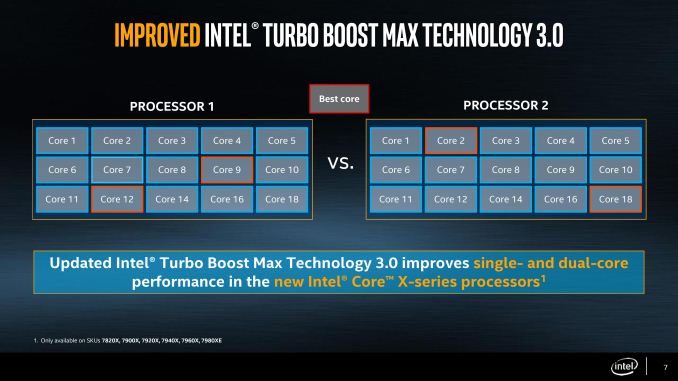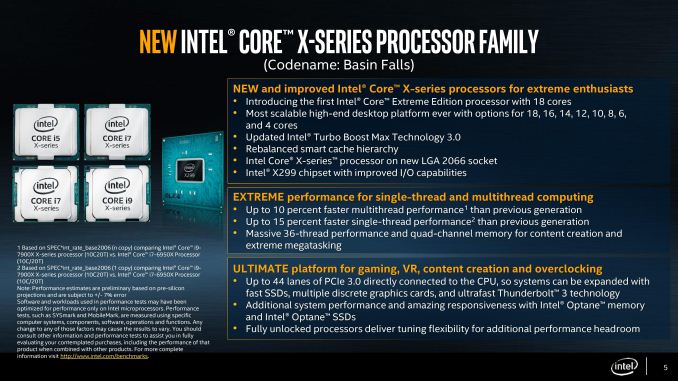Intel Announces Skylake-X: Bringing 18-Core HCC Silicon to Consumers for $1999
by Ian Cutress on May 30, 2017 3:03 AM ESTAnnouncement Four: AVX-512 & Favored Core
To complete the set, there are a couple of other points worth discussing. First up is that AVX-512 support coming to Skylake-X. Intel has implemented AVX-512 (or at least a variant of it) in the last generation of Xeon Phi processors, Knights Landing, but this will be the first implementation in a consumer/enterprise core.
Intel hasn’t given many details on AVX-512 yet, regarding whether there is one or two units per CPU, or if it is more granular and is per core. We expect it to be enabled on day one, although I have a suspicion there may be a BIOS flag that needs enabling in order to use it.
As with AVX and AVX2, the goal here is so provide a powerful set of hardware to solve vector calculations. The silicon that does this is dense, so sustained calculations run hot: we’ve seen processors that support AVX and AVX2 offer decreased operating frequencies when these instructions come along, and AVX-512 will be no different. Intel has not clarified at what frequency the AVX-512 instructions will run at, although if each core can support AVX-512 we suspect that the reduced frequency will only effect that core.
With the support of AVX-512, Intel is calling the Core i9-7980X ‘the first TeraFLOP CPU’. I’ve asked details as to how this figure is calculated (software, or theoretical), but it does make a milestone in processor design. We are muddying the waters a bit here though: an AVX unit does vector calculations, as does a GPU. We’re talking about parallel compute processes completed by dedicated hardware – the line between general purpose CPU and anything else is getting blurred.
Favored Core
For Broadwell-E, the last generation of Intel’s HEDT platform, we were introduced to the term ‘Favored Core’, which was given the title of Turbo Boost Max 3.0. The idea here is that each piece of silicon that comes off of the production line is different (which is then binned to match to a SKU), but within a piece of silicon the cores themselves will have different frequency and voltage characteristics. The one core that is determined to be the best is called the ‘Favored Core’, and when Intel’s Windows 10 driver and software were in place, single threaded workloads were moved to this favored core to run faster.
In theory, it was good – a step above the generic Turbo Boost 2.0 and offered an extra 100-200 MHz for single threaded applications. In practice, it was flawed: motherboard manufacturers didn’t support it, or they had it disabled in the BIOS by default. Users had to install the drivers and software as well – without the combination of all of these at work, the favored core feature didn’t work at all.
Intel is changing the feature for Skylake-X, with an upgrade and for ease-of-use. The driver and software are now part of Windows updates, so users will get them automatically (if you don’t want it, you have to disable it manually). With Skylake-X, instead of one core being the favored core, there are two cores in this family. As a result, two apps can be run at the higher frequency, or one app that needs two cores can participate.
Availability
Last but not least, let's talk about availability. Intel will likely announce availability during the keynote at Computex, which is going on at the same time as this news post goes live. The launch date should be sooner rather than later for the LCC parts, although the HCC parts are unknown. But no matter what, I think it's safe to say that by the end of this summer, we should expect a showdown over the best HEDT processor around.


















203 Comments
View All Comments
Alexvrb - Tuesday, June 6, 2017 - link
[In the near future:]Oh man, they just released a board with THREE M.2 slots! My old board with only TWO (one populated) is now old and outdated!
Iketh - Wednesday, June 7, 2017 - link
You're all technologically ignorant. JKflipflop is most correct here because even tho what ddriver says is true, the cpu must still be designed and traced to work with an existing pin array instead of creating the cpu with a pin array that is efficient to the new cpu architecture. It's not the motherboard anymore, it's the signaling and power routing inside the cpu that matters most.In other words, if JKflip had said "Why would you EVER buy a brand new CPU, then immediately castrate its performance across the board by forcing it to route power and signaling in a way that doesn't jive with it's architecture?" he would have been correct.
theuglyman0war - Thursday, June 8, 2017 - link
Still on x58 with an i7 980x and to be honest I just keep upgrading my gpu's and resent incremental cpu advancement. It is actually the chipset loss that keeps my eyes wandering to ddr4 pci 3.0 lanes and nvme not to mention my horrible sata 3 speeds on my rog III rampage ex which are hard to get around and not feel ghetto despite the pascal ti sli.:(
Them chipset features sure do add up after a while.
sharath.naik - Thursday, June 8, 2017 - link
JKflipflop, Iketh you both are brainwashed. If you are not go head and explain how much more you need to pay for boot raid options with x299?(Or you did not know you will have to pay up to 300$ more to unlock features of x299 motherboard)? if you did not know this, then yes brainwashed is the only word that can be used for you two.LithiumFirefly - Friday, June 9, 2017 - link
What completely baffles me is why an Intel fanboy would defend buying a new Intel high-end desktop line after the last one, x99. The X99 PCH I bought only had six chips made for it, four of them are bonkers price and the other two are gimped. The Broadwell-e update was a joke the older Haswell chips overclocked way better so they were faster than the newer stuff yeah I'm definitely going to try the new Intel stuff after that. /smelgross - Thursday, June 1, 2017 - link
You can't just double the core count. Where are they going to put those cores? I assume that the silicon isn't just sitting there waiting for them.mickulty - Saturday, June 3, 2017 - link
All of AMD's high-end CPUs are based on the same 8-core die, "zeppelin". Ryzen is one zeppelin, threadripper is two connected by infinity fabric on a multi-chip module, naples is four again connected by infinity fabric on a MCM. AMD could very easily put out a chip with more zeppelins, although maintaining socket compatibility would mean losing some i/o capability.Interestingly this means Ryzen has 32 PCIe lanes on the chip but only 16 are actually available on AM4. Presumably this is something to do with Bristol Ridge and Raven Ridge AM4 compatibility since they have less lanes.
theuglyman0war - Thursday, June 8, 2017 - link
why not? just make the socket bigger and increase my utility bill ( or at least give me the option to suffer power if I wanna )Supposedly processing power is only limited by the size of the universe theoretically. :)
theuglyman0war - Thursday, June 8, 2017 - link
isn't silicon just sand?ddriver - Tuesday, May 30, 2017 - link
AMD will not and doesn't need to launch anything other than 16 core. Intel is simply playing the core count game, much like it played the Mhz game back in the days of pentium4. More cores must be better.But at that core count you are already limited by thermal design. So if you have more cores, they will be clocked lower. So it kind of defeats the purpose.
More cores would be beneficial for servers, where the chips are clocked significantly lower, around 2.5 Ghz, allowing to hit the best power/performance ratio by running defacto underclocked cores.
But that won't do much good in a HEDT scenario. And AMD does appear to have a slight IPC/watt advantage. Not to mention offering significantly better value due to better price/performance ratio.
So even if intel were to launch an 18 core design, that's just a desperate "we got two more cores" that will do little to impress potential customers for that market niche. It will be underclocked and expensive, and even if manages to take tangible lead against a 16 core threadripper, it will not be worth the money.